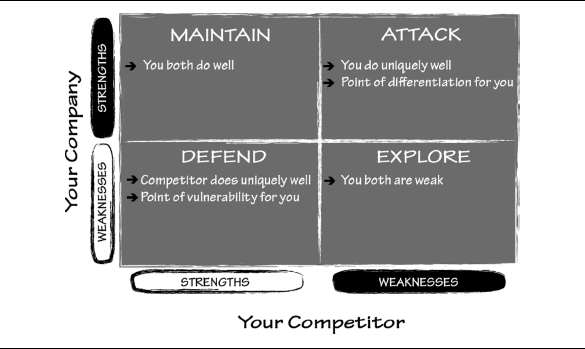Competitive Differentiation Analysis
Armed with this competitive information, you are ready to run what we call a Competitive Differentiation Analysis, which will identify your strengths and weaknesses against those of your competition. Your focus here will shift from gathering information to developing competitive insight—specifically, determining where you and the competition are both vulnerable when considering product, value, politics, and strategy.
The most dangerous strategic condition exists when a supplier is vulnerable but unaware of it. This should prompt you to identify your own weaknesses that you may not be aware of, while also seeking to identify competitive weakness. In addition, you will identify your strengths against those of your competition with the intent of fully leveraging yours and be able to sidestep the competition.
The Competitive Differentiation Analysis is a matrix with four quadrants, as shown in Figure 12.4.
Figure 12.4: The Competitive Differentiation Analysis

The Maintain box in the upper left quadrant shows the strengths you share with your competitor. For example, if an individual in the customer’s Power Base perceives that both your own and your competitor’s products are reliable, then reliability is not a point of differentiation for either of you. This quadrant is so labeled because you want to sustain the customer’s perception that you meet ...
Get The New Power Base Selling: Master The Politics, Create Unexpected Value and Higher Margins, and Outsmart the Competition now with the O’Reilly learning platform.
O’Reilly members experience books, live events, courses curated by job role, and more from O’Reilly and nearly 200 top publishers.

